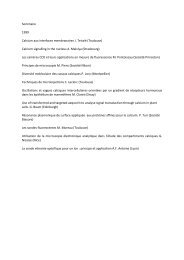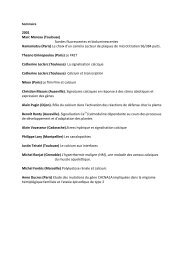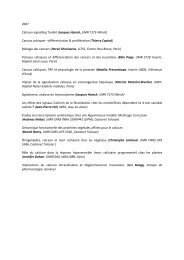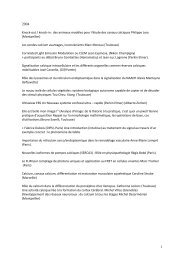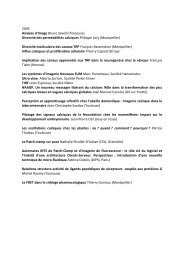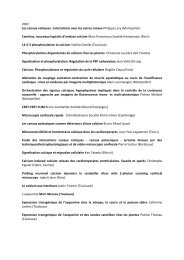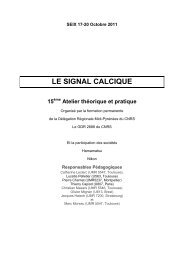SEIX 17-20 octobre 2005 - Atelier Calcium
SEIX 17-20 octobre 2005 - Atelier Calcium
SEIX 17-20 octobre 2005 - Atelier Calcium
Create successful ePaper yourself
Turn your PDF publications into a flip-book with our unique Google optimized e-Paper software.
CONCLUSION:<br />
L‟approche génétique a permis d‟identifier des gènes clés intervenant dans la voie de<br />
signalisation Nod. Il devient maintenant possible d‟étudier cette voie d‟un point de vue<br />
fonctionnel notamment en relation avec la signalisation calcique. Ainsi les champs de<br />
recherche à explorer concernent notamment les rôles de DMI1 et DMI2 dans la génération des<br />
oscillations calciques et le rôle de DMI3 dans le décodage de ce signal. Par ailleurs,<br />
l‟existence de deux réponses calciques distinctes, nécessitant pour leur induction des<br />
concentrations différentes en facteurs Nod suggère l‟existence de plusieurs récepteurs ou d‟un<br />
système de perception multi-composantes présentant des affinités ou des mécanismes<br />
d‟activation différents.<br />
Bibliographie:<br />
Ané JM, Kiss GB, Riely BK, Penmetsa RV, Oldroyd GE, Ayax C, Levy J, Debellé F, Baek JM, Kalo P,<br />
Rosenberg C, Roe BA, Long SR, Dénarié J, Cook DR (<strong>20</strong>04) Medicago truncatula DMI1 required<br />
for bacterial and fungal symbioses in legumes. Science, Vol 303, pp 1364-1367<br />
Catoira R, Galera C, de Billy F, Penmetsa RV, Journet EP, Maillet F, Rosenberg C, Cook D, Gough C,<br />
Dénarié J (<strong>20</strong>00) Four genes of Medicago truncatula controlling components of a Nod factor<br />
transduction pathway. Plant Cell 12: 1647-1666<br />
Cullimore JV, Ranjeva R, Bono JJ (<strong>20</strong>01) Perception of lipo-chitooligosaccharidic Nod factors in legumes.<br />
Trends Plant Sci 6: 24-30<br />
den Hartog M, Musgrave A, Munnik T (<strong>20</strong>01) Nod factor-induced phosphatidic acid and diacylglycerol<br />
pyrophosphate formation: a role for phospholipase C and D in root hair deformation. Plant J 25: 55-65<br />
Dénarié J, Debellé F, Prome JC (1996) Rhizobium lipo-chitooligosaccharide nodulation factors: signaling<br />
molecules mediating recognition and morphogenesis. Annu Rev Biochem 65: 503-535<br />
Ehrhardt DW, Atkinson EM, Long SR (1992) Depolarization of alfalfa root hair membrane potential by<br />
Rhizobium meliloti Nod factors. Science 256: 998-1000<br />
Endre G, Kereszt A, Kevei Z, Mihacea S, Kalo P, Kiss GB (<strong>20</strong>02) A receptor kinase gene regulating<br />
symbiotic nodule development. Nature 4<strong>17</strong>: 962-966<br />
Engstrom EM, Ehrhardt DW, Mitra RM, Long SR (<strong>20</strong>02) Pharmacological analysis of Nod factor-induced<br />
calcium spiking in Medicago truncatula. Evidence for the requirement of type IIA calcium pumps and<br />
phosphoinositide signaling. Plant Physiol 128: 1390-1401<br />
Felle HH, Kondorosi E, Kondorosi A, Schultze M (1998) The role of ion fluxes in Nod factor signalling in<br />
Medicago sativa. Plant J 13: 455-463<br />
Felle HH, Kondorosi E, Kondorosi A, Schultze M (1999) Elevation of the cytosolic free [Ca2+] is<br />
indispensable for the transduction of the Nod factor signal in alfalfa. Plant Physiol 121: 273-280<br />
Levy J, Bres C, Geurts R, Chalhoub B, Kulikova O, Duc G, Journet EP, Ane JM, Lauber E, Bisseling T,<br />
Dénarié J, Rosenberg C, Debellé F (<strong>20</strong>04) A putative Ca2+ and calmodulin-dependent protein kinase<br />
required for bacterial and fungal symbioses. Science 303: 1361-1364<br />
Limpens E, Franken C, Smit P, Willemse J, Bisseling T, Geurts R (<strong>20</strong>03) LysM domain receptor kinases<br />
regulating rhizobial Nod factor-induced infection. Science 302: 630-633<br />
Pingret JL, Journet EP, Barker DG (1998) Rhizobium Nod factor signaling. Evidence for a G proteinmediated<br />
transduction mechanism. Plant Cell 10: 659-672<br />
Radutoiu S, Madsen LH, Madsen EB, Felle HH, Umehara Y, Gronlund M, Sato S, Nakamura Y, Tabata S,<br />
Sandal N, Stougaard J (<strong>20</strong>03) Plant recognition of symbiotic bacteria requires two LysM receptor-like<br />
kinases. Nature 425: 585-592<br />
Shaw SL, Long SR (<strong>20</strong>03) Nod factor elicits two separable calcium responses in Medicago truncatula root hair<br />
cells. Plant Physiol 131: 976-984<br />
Walker SA, Viprey V, Downie JA (<strong>20</strong>00) Dissection of nodulation signaling using pea mutants defective for<br />
calcium spiking induced by Nod factors and chitin oligomers. Proc Natl Acad Sci U S A 97: 13413-<br />
13418<br />
31



